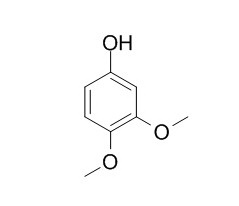3,4-Dimethoxyphenol
3,4-Dimethoxyphenol has antimicrobial activity; it also has inhibition of melanin synthesis, it may be used as whitening agents in cosmetics.
Inquire / Order:
manager@chemfaces.com
Technical Inquiries:
service@chemfaces.com
Tel:
+86-27-84237783
Fax:
+86-27-84254680
Address:
1 Building, No. 83, CheCheng Rd., Wuhan Economic and Technological Development Zone, Wuhan, Hubei 430056, PRC
Providing storage is as stated on the product vial and the vial is kept tightly sealed, the product can be stored for up to
24 months(2-8C).
Wherever possible, you should prepare and use solutions on the same day. However, if you need to make up stock solutions in advance, we recommend that you store the solution as aliquots in tightly sealed vials at -20C. Generally, these will be useable for up to two weeks. Before use, and prior to opening the vial we recommend that you allow your product to equilibrate to room temperature for at least 1 hour.
Need more advice on solubility, usage and handling? Please email to: service@chemfaces.com
The packaging of the product may have turned upside down during transportation, resulting in the natural compounds adhering to the neck or cap of the vial. take the vial out of its packaging and gently shake to let the compounds fall to the bottom of the vial. for liquid products, centrifuge at 200-500 RPM to gather the liquid at the bottom of the vial. try to avoid loss or contamination during handling.
Mol Biol Rep.2024, 51(1):117.
Industrial Crops and Products2021, 163:113313.
Int J Oncol.2019, 55(1):320-330
Saf Health Work.2019, 10(2):196-204
Research Square2021, 10.21203.
Anal Bioanal Chem.2020, 412(12):3005-3015.
Nutrients.2017, 10(1)
Nutrients.2024, 16(14):2267.
Cells. 2023, 12(15):1934.
Sci Rep.2017, 7:467-479
Related and Featured Products
Daru. 2013 Feb 27;21(1):15.
5,6-Dimethoxybenzofuran-3-one derivatives: a novel series of dual Acetylcholinesterase/Butyrylcholinesterase inhibitors bearing benzyl pyridinium moiety.[Pubmed:
23445881]
Several studies have been focused on design and synthesis of multi-target anti Alzheimer compounds. Utilizing of the dual Acetylcholinesterase/Butyrylcholinesterase inhibitors has gained more interest to treat the Alzheimer's disease. As a part of a research program to find a novel drug for treating Alzheimer disease, we have previously reported 6-alkoxybenzofuranone derivatives as potent acetylcholinesterase inhibitors. In continuation of our work, we would like to report the synthesis of 5,6-dimethoxy benzofuranone derivatives bearing a benzyl pyridinium moiety as dual Acetylcholinesterase/Butyrylcholinesterase inhibitors.
METHODS AND RESULTS:
The synthesis of target compounds was carried out using a conventional method. Bayer-Villiger oxidation of 3,4-dimethoxybenzaldehyde furnished 3,4-Dimethoxyphenol. The reaction of 3,4-Dimethoxyphenol with chloroacetonitrile followed by treatment with HCl solution and then ring closure yielded the 5,6-dimethoxy benzofuranone. Condensation of the later compound with pyridine-4-carboxaldehyde and subsequent reaction with different benzyl halides afforded target compounds. The biological activity was measured using standard Ellman's method. Docking studies were performed to get better insight into interaction of compounds with receptor.
The in vitro anti acetylcholinesterase/butyrylcholinesterase activity of compounds revealed that, all of the target compounds have good inhibitory activity against both Acetylcholinesterase/Butyrylcholinesterase enzymes in which compound 5b (IC50 = 52 ± 6.38nM) was the most active compound against acetylcholinesterase. The same binding mode and interactions were observed for the reference drug donepezil and compound 5b in docking study.
CONCLUSIONS:
In this study, we presented a new series of benzofuranone-based derivatives having pyridinium moiety as potent dual acting Acetylcholinesterase/Butyrylcholinesterase inhibitors.
Microbiol Res. 2002;157(3):207-11.
The antimicrobial activity of Aspergillus fumigatus is enhanced by a pool of bacteria.[Pubmed:
12398291 ]
METHODS AND RESULTS:
In a screening program for new antibiotic producers, a strain of Aspergillus fumigatus was isolated from Brazilian soil samples. A pool of autoclaved bacteria was added to part of the fungus culture on the second day of fermentation to increase antibiotic production. The chloroform extract from the culture broth to which the pool of autoclaved bacteria was added showed an increase of 55%, 63% and more than 100% in activity against Staphylococcus aureus, Candida albicans and Micrococcus luteus, respectively. Also, the HPLC chromatographic profiles of the chloroform extracts from both culture conditions were different.
CONCLUSIONS:
Two active compounds were isolated from the broth of the culture grown in the presence of pooled bacteria and were identified as 3,4-Dimethoxyphenol and 1,3,5-trimethoxybenzene.
Yakugaku Zasshi. 2006 Mar;126(3):173-7.
Synthesis and cosmetic whitening effect of glycosides derived from several phenylpropanoids.[Pubmed:
16508241]
Plant-derived phenylpropanoid compounds (4-ethyl-2-methoxyphenol, 2,6-dimethoxyphenol, 2,3-dimethoxyphenol, 3,4-Dimethoxyphenol, 3,5-dimethoxyphenol, 3,4-dihydroxycinnamic acid, 4-hydroxy-3-methoxycinnamic acid, and 3-hydroxy-4-methoxycinnamic acid) were glycosidated to form glycoside compounds.
METHODS AND RESULTS:
We evaluated the effects of these compounds on the inhibition of tyrosinase and melanin synthesis and their cytotoxicity from the viewpoint of their use as whitening agents in cosmetics.
CONCLUSIONS:
Some compounds had more potent tyrosinase-inhibiting activity than commercial arbutin, which was used as a control, and showed no cytotoxicity at low concentration ranges.



